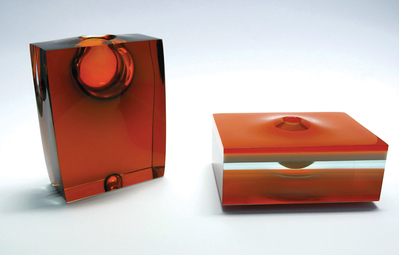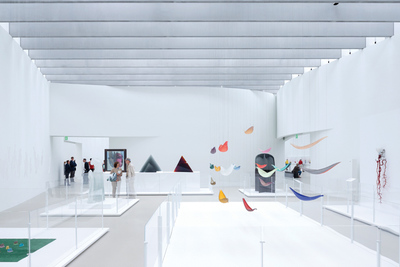Tom Patti

Tom Patti with study for Berkshire Museum’s ECHOES IN SPACE. Photo: Paul Rocheleau.
Tom Patti operates on multiple tracks. He is an artist who thinks like a scientist and engineer. That capability made him a pioneer among sculptors in glass—one whose vision and inventiveness produced objects unlike any other in his field.
Over a 40-year career, Patti helped elevate glass from a decorative to an expressive art form. He made groundbreaking discoveries in fusing commercial sheet glass and laminating it with polymer plastics at a time when others were melting glass in furnaces and shaping it into vases, paperweights and leaded windows. The objects and installations he creates look like architectural systems that shift color, depth and transparency as light and the viewer’s position change.
Much of what he does has grown out of partnerships with industrial manufacturers, a relationship artists of his generation—Patti is 72—often disdained as compromising. He has been awarded research grants and enlisted for consultancies by PPG Industries, GE, and Owens-Corning among others. The executives who run them, he claims, understand and support his work in ways that laymen, even fellow artists, seldom do.

BART Station at Oakland International Airport (South Wall detail): Tom Patti, PERIODIC MOTION, glass, 8 x 200′. Photo: Michael Short.
What he gains from such relationships, he said, is access to new materials and processes that can push his work forward. What he offers in return is creative thinking that can spark innovations in product research.
That was the kind of exchange he stepped into during a recent six-month residency sponsored by Corning Incorporated and the Corning Museum of Glass in Corning, NY. “It was made specific that I was to think outside of the box,” Patti told me in an interview at his Pittsfield studio. His initial goal was to investigate how temperatures outside those used in traditional glass studios affect different kinds of glass. He ended up moving in a somewhat different direction but declined to be specific because of a confidentiality agreement with Corning Museum.
Glen Cook, the museum’s chief scientist who heads the new Specialty Glass Artist Residency, described it as “an opportunity for artists and scientists to stretch themselves.”

Tom Patti, VERTICAL STARPHIRE WITH ORANGE AND AZURLITE, glass, 6 x 4 5/8 x 2 3/4″; Tom Patti, HORIZONTAL CONTOUR STARPHIRE WITH ORANGE AND AZURLITE, glass, 2 7/8 x 6 x 5 1/16″. Courtesy of the artist.
While the two may approach problems with different mindsets and goals, he said “the roots of the creative process are the same.” They lie in the free-flowing moments of brainstorming before the thought process becomes bounded by what it’s meant to accomplish. “Tom is really good a bridging those worlds,” he said.
Patti was the second artist enlisted. Sculptor Albert Paley, who sought ways of bonding certain glasses to metal, was the first. Residencies are by invitation only. A steering committee scouts for established artists whose work lends itself to the exploratory nature of the program and who have a track record for collaboration, Cook said. There is no remuneration other than expenses.
Recipients actually spend only a few weeks out of the six months in Corning, he explained, first to narrow what they want to explore, then to process what they’ve absorbed in “four or five focused engagements.” There is no obligation to produce a body of work.
Patti was known to the Corning Museum long before his residency. Greatly expanded last March by a $64 million contemporary art and design wing, it has more than a dozen of his small-scale artworks in its collection. Others are in New York’s Museum of Modern Art, the Art Institute of Chicago and elsewhere in the United States and Europe.

Corning’s new Contemporary Art + Design Wing. Photo: Iwan Baan.
William Warmus, a former curator at Corning, described Patti’s work in a catalog essay for a 2004 retrospective in Tacoma, WA, as “metaphorical expressions of architecture, landscape and life forms. ” He likened them to James Turrell’s Sky Window series of the 1970s that “frame the sky and draw attention to its subtly shifting colors.”
Patti grew up in an industrial environment with Pittsfield’s biggest employer, GE, as his backyard. He remembers watching 15 million volts of manmade lightning flash between two generators at the company’s dedication of its ultra-high-voltage laboratory in 1949.
A boyhood mishap with a toy left him blind in one eye, a visual disability that’s affected aspects of his life, but not his art, he said.
A gifted student, he entered New York’s Pratt Institute on a full scholarship in 1963 to study industrial design and architectural theory. A star performer, he attracted teaching opportunities and research grants. He took part in Robert Rauschenberg’s Experiments in Art and Technology project in 1966 to promote collaboration between artists and engineers and later studied ways to use inflatable substances such as latex as structural building materials.
That led him to experiment with thin-shell structures that could maximize habitable space and be viewed simultaneously from within and without. It was a logical next step, in the early 1970s, to glass.
Untrained in traditional glassmaking methods, he scrounged commercial sheet glass from dumpsters and abandoned buildings and taught himself how to fuse them together under heat and pressure in an oven of his own design. Using such homemade technology, he became the first to combine the two major glass-working traditions—fusing and blowing—by forcing a bubble of air through a stack of fused plates to produce a hollow shape.
It was, said his longtime gallerist Douglas Heller, “unlike anything we ever encountered. It stood defiantly and compellingly apart from the familiar.”
Patti made his breakthrough, ironically, at the height of the midcentury studio-glass movement that was putting handcrafting back into glass working.
“Everyone was interested in the liquid medium and expressing that quality of it,” he said, “but I thought the language of our time was really the industrial glass technology that was being developed. When you’re putting up buildings 100 stories-plus and a curtain-wall system of sheer glass, that’s the language of our time.”
Sidestepping the fast-paced methods of furnace-fired glassblowing used by artists like Dale Chihuly, he developed a slower, more concentrated, oven-heating process that gave him time to think about and use tools to shape forms while they were still inside the oven. The oven he uses today is the 18-ton, high-pressure device that NASA used to develop the graphite composite exterior of the Stealth Bomber.
Besides his wife Marilyn, who manages their business, he works with only one part-time assistant.
A 1980 commission brought plastics into his repertoire. GE invited him to work with its scientists on laminating and thermoforming fabrication processes for a site-specific sculpture to stand in its new plastics division headquarters in Pittsfield. The piece is now at the Museum of Fine Arts in Houston. Through it, he found he could laminate glass between sheets of polymer plastic film, varying the types of glass to produce embedded designs that can look transparent, translucent or opaque, change color and create an illusion of depth as light changes or the viewer moves. “I try to get a feeling of deep space in a very shallow field,” he said.

Tom Patti, detail of the work being done at Corning. Courtesy of the artist.
His innovations were not particularly profitable in early days, and he took outside jobs to help support his family—menial work like washing dishes and mending glass knickknacks to avoid compromising his artistic focus.
The economic outlook brightened in the 1990s as his gallery and museum shows drew media attention that translated into full-scale architectural commissions based on his small-scale concepts.
Designated a Massachusetts Living Treasure by the Massachusetts Foundation on the Arts, he has three such commissions in public places in the Commonwealth: the Museum of Fine Arts, Boston (not currently on view); the Eric Carle Museum of Picture Book Art in Amherst; and the Berkshire Museum in Pittsfield, which he haunted as a youngster for its art and science exhibits.
The Berkshire Museum and Eric Carle Museum pieces both take concept cues from their educational contexts. The three-panel Eric Carle piece resembles a picture book whose colored and textured geometric shapes viewers can scan as if browsing pages of text.
The Berkshire Museum commission is part of the lobby’s architecture. Patti replaced existing, clear-glass partitions and doors with panels embedded with geometric and biomorphic shapes that shift in color and transparency as the light changes. Cued to the museum’s triple role as an institution of art, science and history, they are meant to catch the eyes of visitors and lead them forward. He calls them “way finding” devices.
“He doesn’t necessarily want his work to answer some question,” said Maria Mingalone, the museum’s director of interpretation, who has known Patti for 15 years. “He’s providing an opportunity for people to imagine and wonder and to contemplate mysteries.”
She paused for a moment to recall a remark once made about him and said, “If he knew that what he was doing couldn’t be done, he would never have accomplished it.”
Charles Bonenti lives in Williamstown and is an art critic for The Berkshire Eagle. He is a regular contributor to Art New England.
